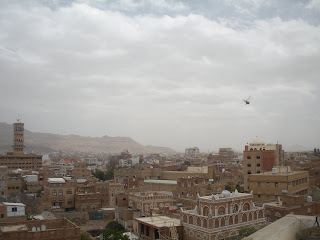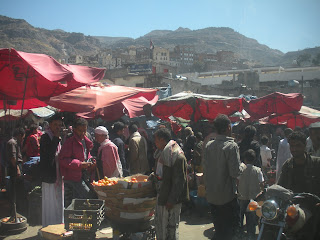After a winding night-time drive through, around, and down the mountain spine from Jiblah to Taizz, we finally arrived at our hotel in Yemen’s second city. Taizz is Yemen’s most populous city next to Sanaa, closely followed by Hudaydah, a seaside town on Yemen’s Red Sea coast and Sanaa’s main port. Many of the teachers at our school come from Taizz, which speaks to two important points about the city: one, that the population of Taizz is often better educated than in other cities, and two, that the “sons of Taizz” are often forced to find work elsewhere. The Saleh government’s Sanaa-centric policies have led to immense unemployment in Taizz, forcing those who are able to find work elsewhere.
Our hotel was actually quite nice, although it probably wouldn’t be considered so in the U.S. I did find one dead mosquito, but I wasn’t too worried since I had grabbed a motorcycle to the nearest pharmacy during my lunch break the day before and picked up some Malaria pills. After a quick dinner at a nearby restaurant we took a stroll through Taizz’s old market. I was excited to find stacks of Taizz’s famous cheese wheels, which taste similar to smoked gouda. It’s a refreshing change from the feta-dominated Sanaani diet. Unfortunately all the cheese vendors had their delicious products sitting out in the open among swarms of flies, so I wasn’t too inclined to purchase a wheel at the time.
We turned back to the hotel where we hung out in the lobby with the staff, huddled around the TV watching the latest from Egypt. This was February 10, and Mubarak had not yet resigned. Anticipation ran high, and Aljazeera announced that Mubarak would be making a speech later that night. I was glad I didn’t stay up to hear it since it ended up being just as much a let down as his other over-hyped statements over the previous days.
As we watched the crowds swarm in Egypt’s streets, defying a curfew that from the beginning had never existed except on paper, the talk eventually turned to Yemen. Yemen’s protest movement would fizzle out, the staffers said. We like qat too much and since it’s chewed in the afternoons we could never sustain a protests movement over weeks. Everyone will eventually go home to chew, he said, munching on his own bag of leaves. We fear the violence that could follow upheaval.
Mubarak fled to Sharm al-Sheikh the following night, bringing Yemen’s dying opposition protests back to life. In the early days of the revitalization, Taizz would become the center of the strongest protests and one of the first cities beside Aden to witness lethal violence against demonstrators. Back in Sana’a, both pro- and anti-government demonstrators eventually got around the qat problem by simply camping out in their chosen protest locations and finding sponsors to distribute the leaf to the protestors. The GPC first pioneered this strategy in order to attract supporters to its rally in Tahrir Square.
In the morning we headed straight to Qalaat al-Qahira (Castle of Victory or Fortress of Impregnability, whichever you prefer). This was another castle perched atop a rocky hill overlooking a city, much like Husn Hubb. Qahira, however, seemed a bit more practical. Husn Hubb was so far above, so far removed from life in the city it protected that I can’t imagine any garrison making it down to the city in time to fend off attackers.
Qahira was a little more accessible and much more complete as far as ruins go. Built in the Rusulid period (13th – 15th century), the castle now sports conspicuous “restored” areas built with modern materials based on someone’s guess of what the castle might have once looked liked. Our archaeologist and anthropologist debated whether this was a good thing. On the one hand the rebuilt castle made a nice picnic spot, which could attract tourists, and on the other hand it compromised the building’s historical integrity.
In any case, the views from the top of the castle were incredible. The city shone white in the intense morning sun, the valley filled with houses as far as the eye could see. The terraced mountain sides behind the castle were just starting to turn green. Mounted on the upper parts of the castle were anti-aircraft guns covered with tarps. I presume these were built for defense against dragons.
We left the castle in late morning, grabbed some juice and water, and drove straight up Jabal Sabr (mountain of forbearance), the tallest mountain of the range that forms the valley enclosing Taizz. A long winding drive through the switchbacks leading up the mountain, and one or two spectacular overlooks, finally brought us to the even more spectacular summit.
Atop Jabal Sabr I first truly witnessed the incomprehensible natural beauty of Yemen. I simply could not process the changes in elevation confronting my vision, the immense range of vertical view from mountain top to valley floor and again horizontally from our mountain top to the ridge on the opposite side of the valley, dozens of kilometers away. The mountains themselves looked fertile yet stubborn, only giving up growth to those who take the time to coax vegetation from their rocky terraces. Somehow, I hear the view is even more spectacular in the early summer when the dun mountains explode in green.
We descended Jabal Sabr around midday and ate salta for lunch in the old market area. From there we visited the al-Ashrafiya Mosque, also built during the Rasulid period. It too is currently being restored, but this time attention is being paid to detail. A team of Italians and Yemenis are currently undertaking the project, taking special care that the final product reflects the mosque’s original state. Like many of the mosques I’ve seen in Yemen, I was taken aback by the beauty of its white-washed walls and the intricacy of its interior carvings. We even got the chance to see its catacombs, which house both graves and former classrooms from the mosque’s days as a religious school.
Before we entered, we had to sit around and wait for someone to deliver the mosque’s key. It was locked but we had run into the key-holder before lunch and he promised to open it up for us after noon prayer. A bunch of adorable kids kept us company while waiting, all very enthusiastic to have their picture’s taken.
After visiting the mosque it was time to leave Taizz and drive to Mokha. Taizz opened my eyes to the rest of Yemen; the city definitely had a much different vibe than Sanaa. It was hard to put my finger on just what that was, but it seemed in some ways more laid back and didn’t take itself too seriously. Taizz has its disappointing aspects as well. The narrow market streets were clogged with motorcycles, making any sort of conversation nearly impossible. There was more trash in the streets and more visible poverty. That the educated are forced to leave and find work elsewhere doesn’t help. Despite this, Taizz left a positive impression on me as we pulled away in the Toyota. The next stop was Mokha. I closed my eyes and drifted into sleep.

Portico of the Al-Ashrafiya Mosque

Refurbished interior of Al-Ashrafiya

These kids are hard.

In the Taizz market

Overlook on the way up Jabal Sabr

View of Qalat al-Qahira from the road up Jabal Sabr

Terraced mountain sides on Jabal sabr

View of Taizz from Qalat al-Qahira

Water reservoir at Qalat al-Qahira

View from Qalat al-Qahira

More photos:
Qalat al-Qahira and Jabal Sabr |
Al-Ashrafiya Mosque
 Saleh strongly requested helicopters from General Petraeus during their meeting last January. Get in ze choppah!
Saleh strongly requested helicopters from General Petraeus during their meeting last January. Get in ze choppah!
























